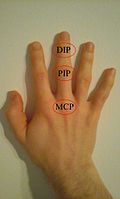This article's lead section may be too technical for most readers to understand.(December 2024) |
| Metacarpophalangeal joint | |
|---|---|
 The palmar aspect of the hand showing the epiphyses of the hand exploded. MCP joints in red. | |
 The DIP, PIP and MCP joints of the hand: MetaCarpoPhalangeal joints, and the interphalangeal joints of the hand:
| |
| Details | |
| System | 099 |
| Identifiers | |
| Latin | articulationes metacarpophalangeae |
| MeSH | D008662 |
| TA98 | A03.5.11.501 |
| TA2 | 1835 |
| FMA | 35246 |
| Anatomical terminology | |
The metacarpophalangeal joints (MCP) are situated between the metacarpal bones and the proximal phalanges of the fingers. [1] These joints are of the condyloid kind, formed by the reception of the rounded heads of the metacarpal bones into shallow cavities on the proximal ends of the proximal phalanges. [1] Being condyloid, they allow the movements of flexion, extension, abduction, adduction and circumduction (see anatomical terms of motion) at the joint. [1]

